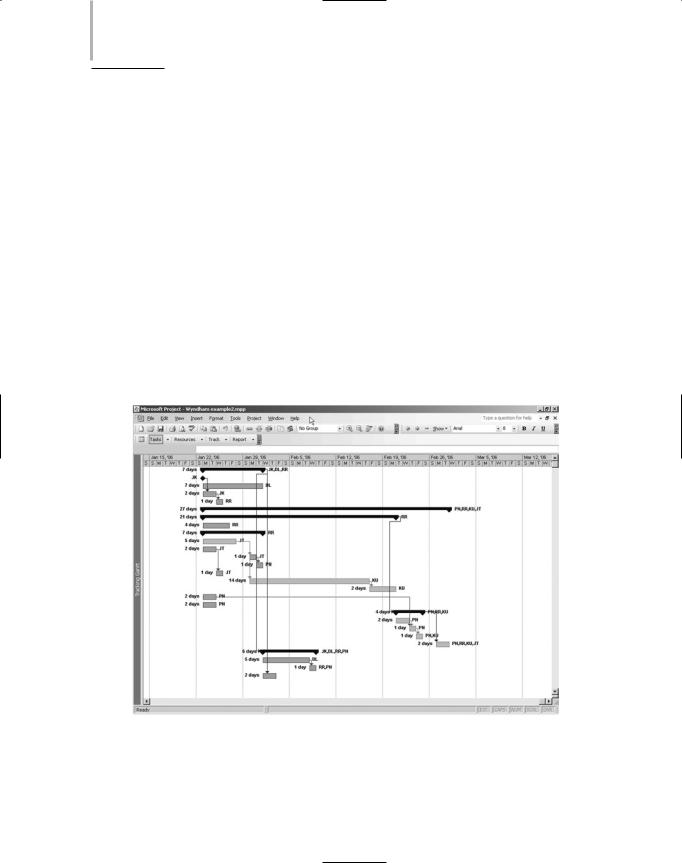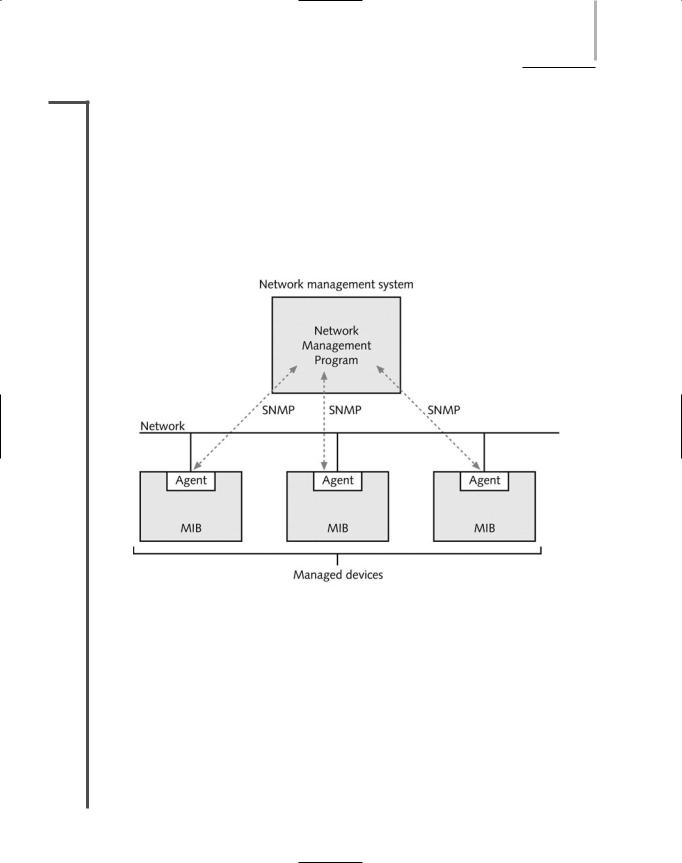
Network Plus 2005 In Depth
.pdf
672 Chapter 15 IMPLEMENTING AND MANAGING NETWORKS
In the case of the Wyndham School District, you have identified a broad need for improving network performance. The performance of different segments and the network as a whole can be measured over time. However, performance goals and the steps necessary to improve performance may be subjective. One of the district’s network engineers might believe that upgrading the network to a fully switched 100BASE-TX solution is the best way to improve performance, whereas the technical manager might think it critical to replace all of the network’s CAT 5 with fiber-optic cable. The choice of which solution to pursue (if not both) might depend on budgetary constraints, ease of installation, technical research that favors one solution, or results from preliminary tests.
Suppose that after interviewing key Wyndham School District staff you discover that the top need for elementary school teaching staff is to improve performance between workstations in the classrooms and servers, which are currently housed in the district’s small data center at the high school. For example, students currently wait between 30 seconds and a minute for popular applications to load over the WAN. Ideally, that time would be cut to 10 seconds. The primary need for middle school and high school teaching staff is improving response time between computers on the LAN and the Internet. For example, using the current fractional T1 to the Internet, students in the foreign language lab wait an average of 15 seconds before a Web-based training tool refreshes its screens. Ideally, teachers want this wait reduced to no more than five seconds. At the same time, technical staff have identified specific WAN performance and security improvements and administrators have established specific budget limits.
Now that you have collected a list of project requirements, you are ready to turn those requirements into project goals.
Setting Project Goals
Project goals help keep a project on track. They are also necessary later when evaluating whether a project was successful. A popular technique for setting project goals is to begin with a broad goal, then narrow it down into specific goals that contribute to the larger goal. For example, one of the Wyndham School District’s goals is to improve performance between its network and the Internet. Beneath that goal, you may insert several smaller goals, such as increasing the throughput of its current Internet connection, connecting to a nationwide ISP, and using a proxy server to cache frequently accessed Web pages.
In addition to being specific, project goals should be attainable. The feasibility study should help determine whether you can achieve the project goals within the given time, budgetary, and staffing constraints. If project goals are not attainable from the outset, you risk losing backing from the project participants, the users, and the managers who agree with the project’s goals and who will strive to help you achieve them. Managers and others who oversee resource allocation are called sponsors. In the Wyndham School District upgrade example, the high school principal and key members of the school board might act as sponsors. Although sponsors do not necessarily participate in project tasks or supervise project teams, they can lobby for the funding necessary to complete the project, appeal to a group of managers to extend a project’s deadline, assist with negotiating vendor contracts, and so on. And if you lose backing, chances



PROJECT MANAGEMENT Chapter 15 675
TIP
You may be asked to plan a project with seemingly impossible deadlines. One technique for making the project fit into a tight time frame is to work backward to create the timeline. Begin at the project’s predetermined endpoint and move toward the beginning of the project, allowing the normal time requirements for tasks. This method highlights which tasks may delay the project and therefore need to be dropped or modified, at least temporarily.
In addition to these elements, project plans may provide information on the amount of flexibility in the timeline, task dependencies, links to other project plans, and so on. With most project planning software, you can add your own columns to the plan and insert any type of information you deem appropriate. For example, if you are managing a very large network design project, you might create a Web site with links to documentation for each phase of the project. In the project plan, you might include a column to list the URLs of the documents for each task or group of tasks.
Communication
Without clear and regular communication, a project will falter. Communication is necessary to ensure that all participants understand the project’s goals, help keep a project’s budget and timeline on track, encourage teamwork, avoid duplicate efforts, and allow learning from previous mistakes. The project manager is responsible for facilitating regular, effective communication among project participants. In addition, the project manager must ensure consistent communication with all project stakeholders.
No matter how small and insignificant your network change appears, if it could potentially affect the way that users accomplish their daily work, you must prepare users for the change. In some cases, the likelihood of a change affecting users is plainly evident. For example, if you upgrade the version of NetWare used by your file servers and therefore must upgrade the Novell networking client version used by clients, every user will see a slightly different screen when she starts up the computer and logs on to the network. If you replace a segment of CAT 3 cabling with CAT 6 cabling, however, users might not notice the difference.
For a major network change, you definitely must inform users. Among other things, explain to users:
How their access to the network will be affected
How their data will be protected during the change (even if you are confident that the data will remain unaffected by the change, explain how the protection works)
Whether you will provide any means for users to access the network during the change
Whether the change will require users to learn new skills

676 Chapter 15 IMPLEMENTING AND MANAGING NETWORKS
Although providing all of this information may seem burdensome, it lessens the possibility that your project might be stymied by negative reaction. To minimize the amount of time spent communicating with users, you might convene company-wide meetings or send mass e- mail distributions. If a network implementation has the potential to drastically change the way that users perform their work, you might want to form a committee of user representatives who can attend project meetings and provide input from the users’ point of view.
Contingency Planning
Even the most meticulously planned project may be derailed by unforeseen circumstances. For instance, a key team participant may quit, your budget may be unexpectedly cut, or a software package may not work as promised. Each of these conditions may threaten to delay your project’s completion. To prepare for such circumstances, you must create a contingency plan at the beginning of the project. Contingency planning is the process of identifying steps that minimize the risk of unforeseen events that could affect the quality or timeliness of the project’s goals.
For example, suppose that as the Wyndham School District network manager, you have only one week—while students are on spring break—to replace older servers with new, high-per- formance servers. Long before that week, you have established an excellent relationship with your hardware vendor. You order the servers two months in advance. However, after six weeks, they still haven’t arrived, due to a quality control problem at the manufacturer. Spring break is nearing, so you arrange with your hardware vendor to ship a slightly different, but similar model of server that’s in stock in case the new servers don’t appear in the coming week. This change may require a modification in your installation process, but it ensures that the upgrade can still occur.
Using a Pilot Network
One of the best ways to evaluate a large-scale network or systems implementation is to first test it in your environment on a small scale. A small-scale network that stands in for the larger network is sometimes called a pilot network. Although a pilot network is much smaller than the enterprise-wide network, it should be similar enough to closely mimic the larger network’s hardware, software, connectivity, unique configurations, and load. If possible, you should establish the pilot network in the same location or environment in which the final network will exist.
The following tips will help you create a more realistic and useful pilot network:
Include at least one of each type of device (whether a critical router or a client workstation) that might be affected by the change.
Use the same transmission methods and speeds as employed on your network.
Try to emulate the number of segments, protocols, and addressing schemes in your network. And, although it is impractical to emulate the same number of nodes, if possible, try to generate a similar amount of traffic.

PROJECT MANAGEMENT Chapter 15 677
Implement the same server and client software and configurations on your pilot network as found in your current network (unless they are part of the change you’re testing).
After you have established the pilot network, test it for at least two weeks to verify that its performance, security, availability, or other characteristics meet your criteria.
TIP
As the pilot network is intended for testing only, do not connect the pilot network to your live network. By keeping the two networks separate, you ensure that experimental changes do not inadvertently harm your functioning network.
The pilot network offers you opportunities to both educate yourself and test your implementation goals. Use your time with the pilot network to become familiar with any new features in the hardware or software. Be certain to document what you learn about the new technology’s features and idiosyncrasies. As you evaluate your results against your predefined test criteria, note where your results show success or failure. All of this documentation provides valuable information for your final implementation and for future baselining.
Testing and Evaluation
After completing each major step in a project, you should assess whether the tasks you’ve completed have achieved their goals. To successfully test your implementation, you must establish a testing plan that includes relevant methods and criteria. For example, your method of testing the network performance may be to use the Windows Server 2003 Network Monitor application from a server. For each performance test you run, you will want to use Network Monitor with the same configuration so that you can compare your results across the various tests. In this case, the criteria you use to measure network performance may be the number of bytes that travel from one particular workstation to the server every five minutes. Testing should help determine whether a change was successful, partially successful, or unsuccessful. It should also reveal any unintended consequences of the change or whether the change revealed the need for additional changes.
In addition, as part of a project’s resolution, you should perform testing to determine whether the project was successful. For example, in the case of Wyndham School District, performance testing should occur after the servers, backbone, and Internet connectivity have been upgraded. Teachers in the elementary schools can time how long they now wait for applications to load from the LAN server. Teachers at the high school can measure how long it takes for a Webbased learning tool to load. IT staff can use network monitoring tools to measure how quickly routers and switches receive and respond to requests. Such quantitative evaluations are necessary to gauge the success of a project. They may also reveal errors introduced during a project, such as an improper switch configuration that causes network congestion.

678 Chapter 15 IMPLEMENTING AND MANAGING NETWORKS
In the following section, you will learn how networks are managed to ensure the best possible performance and availability over time.
Network Management
Network management is a general term that means different things to different networking professionals. At its broadest, network management refers to the assessment, monitoring, and maintenance of all aspects of a network. On some large networks, administrators run network management applications that continually check devices and connections to make certain they respond within an expected performance threshold. If a device doesn’t respond quickly enough or at all, the application automatically issues an alert that pages the network administrator responsible for that device. On a small network, however, comprehensive network management might not be economically feasible. Instead, such a network might run an inexpensive application that periodically tests devices and connections to determine only whether they are still functioning.
Several disciplines fall under the heading of network management (including topics discussed in previous chapters, such as security audits and change management), but all share the primary goal of preventing costly downtime or loss. Ideally, network management accomplishes this by helping the administrator predict problems before they occur. For example, a trend in network usage could indicate when a switch will be overwhelmed with traffic. In response, the network administrator could increase the switch’s processing capabilities (or replace the switch) before users begin experiencing slow or dropped connections. Before you can assess and make predictions about a network’s health, however, you must first measure its baseline status.
Obtaining Baseline Measurements
As you learned in Chapter 12, a baseline is a report of the network’s current state of operation. Baseline measurements might include the utilization rate for your network backbone, number of users logged on per day or per hour, number of protocols that run on your network, statistics about errors (such as runts, collisions, jabbers, or giants), frequency with which networked applications are used, or information regarding which users take up the most bandwidth. The graph in Figure 15-4 shows an example baseline for daily network traffic over a six-week period.
Baseline measurements allow you to compare future performance increases or decreases caused by network changes with past network performance. Obtaining baseline measurements is the only way to know for certain whether a pattern of usage has changed (and requires attention) or, later, whether a network upgrade made a difference. Each network requires its own approach. The elements you measure depend on which functions are most critical to your network and its users.
For instance, suppose that your network currently serves 500 users and that your backbone traffic exceeds 50% at 10:00 A.M. and 2:00 P.M. each business day. That pattern constitutes your baseline. Now suppose that your company decides to add 200 users who perform the same types

NETWORK MANAGEMENT Chapter 15 679
FIGURE 15-4 Baseline of daily network traffics
of functions on the network. The added number of users equals 40% of the current number of users (200/500). Therefore, you can estimate that your backbone’s capacity should increase by approximately 40% to maintain your current service levels.
The more data you gather while establishing your network’s baseline (in other words, the longer you gather data), the more accurate your prediction will be. Network traffic patterns might be difficult to forecast, because you cannot predict users’ habits, effects of new technology, or changes in demand for resources over a given period of time. For instance, the preceding example assumed that all new users would share the same network usage habits as the current users. In fact, however, the new users may generate a great deal more, or a great deal less, network traffic.
How do you gather baseline data on your network? Although you could theoretically use a network monitor or network analyzer and record its output at regular intervals, several software applications can perform the baselining for you. These applications range from freeware available on the Internet to expensive, customizable hardware and software combination products. Before choosing a network baselining tool, you should determine how you will use it. If you manage a small network that provides only one critical application to users, an inexpensive tool may suffice. If you work on a WAN with several critical links, however, you should investigate purchasing a more comprehensive package. The baseline measurement tool should also be capable of collecting the statistics needed. For example, only a sophisticated tool can measure traffic generated by each node on a network, filter traffic according to types of protocols and errors, and simultaneously measure statistics from several different network segments.
A baseline assessment should address the following questions:
Physical topology—Which types of LAN and WAN topologies does your network use: bus, star, ring, hybrid, mesh, or a combination of these? Which type of backbone does your network use—collapsed, distributed, parallel, serial, or a combination of these?
Which type and grade of cabling does your network use?

680Chapter 15 IMPLEMENTING AND MANAGING NETWORKS
Access method—Does your network use Ethernet, Token Ring, wireless, or a mix of transmission methods? What transmission speed does it provide? Is it switched?
Protocols—Which protocols are used by servers, nodes, and connectivity devices?
Devices—How many of the following devices are connected to your network— switches, routers, hubs, gateways, firewalls, access points, servers, UPSs, printers, backup devices, and clients? Where are they physically located? What are their model numbers and vendors?
Operating systems—Which network and desktop operating systems appear on the network? Which versions of these operating systems are used by each device? Which type and version of operating systems are used by connectivity devices such as routers?
Applications—Which applications are used by clients and servers? Where do you store the applications? From where do they run?
If you have not already collected and centrally stored this information, it may take the efforts of several people and several weeks to compile it, depending on the size and complexity of your network. This evaluation involves visits to the telecommunications and equipment rooms, an examination of servers and desktops, a review of receipts for software and hardware purchases, and, potentially, the use of a protocol analyzer or network monitoring software package. A baseline assessment may take a great deal of time and effort to complete, but it promises to save work in the future. After you have compiled the information, organize it into a format (such as a database) that can be easily updated, allowing your staff to keep the baseline current.
NET+ Performance and Fault Management
2.13After establishing a baseline, you are ready to implement an application that assesses your network’s status on an ongoing basis. This process includes both performance management (monitoring how well links and devices are keeping up with the demands placed on them) and fault management (the detection and signaling of device, link, or component faults).
To accomplish both performance and fault management, organizations often use enterprisewide network management software. Some popular applications include HP’s Openview, IBM’s NetView, and Cisco’s CiscoWorks, but hundreds of other such tools exist. All rely on a similar architecture, in which at least one network management console (which may be a server or workstation, depending on the size of the network) collects data from multiple networked devices at regular intervals, in a process called polling. Each managed device runs a network management agent, a software routine that collects information about the device’s operation and provides it to the network management application running on the console. So as not to affect the performance of a device while collecting information, agents do not demand significant processing resources.
A managed device may contain several objects that can be managed, including components such as processor, memory, hard disk, NIC, or intangibles such as performance or utilization.

NETWORK MANAGEMENT Chapter 15 681
NET+ For example, on a server, an agent can measure how many users are connected to the server or
2.13what percentage of the processor’s resources are used at any time. The definition of managed devices and their data are collected in a MIB (management information base).
Agents communicate information about managed devices via any one of several Application layer protocols. On modern networks, most agents use SNMP (Simple Network Management Protocol). SNMP is part of the TCP/IP suite of protocols and typically runs over UDP on port 161 (though it can be configured to run over TCP).
Figure 15-5 illustrates the relationship between a network management application and managed devices on a network.
FIGURE 15-5 Network management architecture
After data is collected, the network management application can present an administrator with several ways to view and analyze the data. For example, a popular way to view data is in the form of a map that shows fully functional links or devices in green, partially (or less than optimally) functioning links or devices in yellow, and failed links or devices in red. One type of network status map generated by Solarwinds.net’s Orion network management software is shown in Figure 15-6.
Because of their flexibility, sophisticated network management applications are also challenging to configure and fine-tune. You have to be careful to collect only useful data and not an excessive amount of routine information. For example, on a network with dozens of routers, collecting SNMP-gener-
